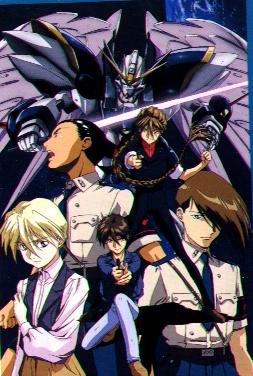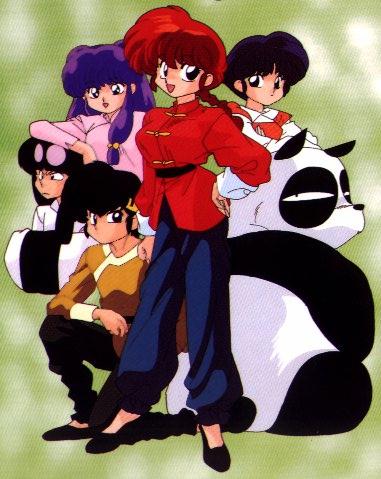Anime 101
The following is an excerpt from The Anime Cafe's Anime
Encyclopedia. Visit the site for a more comprehensive Anime
Information.
Texts were written by Bryan Pfaffenberger
c/o the Anime Cafe
(All respect and credit
should be given to HIM... so, please don't accuse me of
plagiarism)
What
is Anime?
 The term anime refers to a distinctive tradition of Japanese
animation that is almost immediately recognizable by its superior
artistic quality as well as by the somewhat mannered artistic
conventions anime artists employ, such as the preference for
child-like, large eyes. But it's not just the art that grabs one's
attention.
The term anime refers to a distinctive tradition of Japanese
animation that is almost immediately recognizable by its superior
artistic quality as well as by the somewhat mannered artistic
conventions anime artists employ, such as the preference for
child-like, large eyes. But it's not just the art that grabs one's
attention.
In contrast to the flat, Good vs.
Evil plots in U.S. cartoons, many anime stories deal with complex,
thought-provoking themes, presenting complex characters that
change as the stories progress. There's a ready acceptance of the
reality of death. In some anime, even those intended for kids,
main characters sometimes die. Although there's as much silliness
and trash in anime as in any other popular medium, it's a fair
generalization to say that it's a more intelligent genre than
American cartoons. For anyone used to Disney's predictable plots
and platitudes, one's first encounter with anime produces shock,
followed by fascination. It's serious stuff.
Anime alo provides a window into
another culture. In ways that many anime fans scarcely guess,
anime draws strongly from Japanese and wider Asian mythology and
symbolism generally, and specifically from the rich Japanese
traditions of Shinto, the martial arts, and Zen.
Some of the most interesting
anime explore the implications of technologies that blurs the
distinctions between machine and person, male and female, good
and evil, leaving the characters groping to find their moorings.
In contrast to American explorations of advanced technology (as
in Star Wars and the Terminator films), which subsume all the
issues under the "absolute good vs. absolute evil" and
"happy ending" tropes, anime deeply explores the moral
and spiritual ambiguities of life and culture in a world pushed
over the edge by rampaging technological progress.
What
is Manga?
Japanese comics are called manga. Many anime series got their start as
popular manga. An industry with $3 billion annual sales in Japan,
manga account for as much as 60 percent of all printed materials
sold in that country, and are very avidly read--so much so, in
fact, that addiction is something of a problem. Japanese smile
wryly when they refer disparagingly of otaku, over-the-top manga
fans whose filthy, cluttered homes are stacked to the rooftop
with manga.

Rurouni Kenshin is a very
popular manga series in Japan
Why
is a parents' guide to Anime Needed?
 Some anime are expressly designed for
children, and some can be enjoyed by the entire family. Others--including
many series originally broadcast on Japanese television--contain
material that some parents will find objectionable, even though
other parents wouldn't hesitate to share these videos with their
kids. And some are explicitly designed for adult audiences and
shouldn't be shared with children.
Some anime are expressly designed for
children, and some can be enjoyed by the entire family. Others--including
many series originally broadcast on Japanese television--contain
material that some parents will find objectionable, even though
other parents wouldn't hesitate to share these videos with their
kids. And some are explicitly designed for adult audiences and
shouldn't be shared with children.
Another point parents should
bear in mind about anime is that, in Japanese culture, casual
nudity isn't considered to be harmful to children. Many quite
innocent anime videos, designed for broadcast on Japanese TV,
contain brief nudity in non-sexual situations (for example, in
public baths, which are very much part of traditional Japanese
culture). Non-Japanese parents will need to decide for themselves
whether this content is appropriate for their children.
Unlike American animated films
intended for children's audiences, anime tends to deal much more
realistically with evil and death. The classic American villain--wholly
evil, and not very believable--gives way to complex characters
with whom one can partly sympathize. Anime is often thought-provoking
and provides an excellent foundation for raising important issues
with your children.
What about gender and sex roles?
Parents should realize that Japan isn't as "liberated"
as the U.S. with respect to the presence of women in the
professions, and some anime reflect this and portray women in
traditional, submissive roles. This isn't necessarily a liability;
evidence of this difference could provide an occasion for
discussing cultural differences and historical change with your
kids. On the whole, though, anime authors are probably more
liberal than Japanese society, and one finds many anime with
strong, independent female characters. The best anime transcend
stereotypes by exploring the complexity of characters' emotions
regarding relationships.

MORE!
HOME
 The term anime refers to a distinctive tradition of Japanese
animation that is almost immediately recognizable by its superior
artistic quality as well as by the somewhat mannered artistic
conventions anime artists employ, such as the preference for
child-like, large eyes. But it's not just the art that grabs one's
attention.
The term anime refers to a distinctive tradition of Japanese
animation that is almost immediately recognizable by its superior
artistic quality as well as by the somewhat mannered artistic
conventions anime artists employ, such as the preference for
child-like, large eyes. But it's not just the art that grabs one's
attention.
 Some anime are expressly designed for
children, and some can be enjoyed by the entire family. Others--including
many series originally broadcast on Japanese television--contain
material that some parents will find objectionable, even though
other parents wouldn't hesitate to share these videos with their
kids. And some are explicitly designed for adult audiences and
shouldn't be shared with children.
Some anime are expressly designed for
children, and some can be enjoyed by the entire family. Others--including
many series originally broadcast on Japanese television--contain
material that some parents will find objectionable, even though
other parents wouldn't hesitate to share these videos with their
kids. And some are explicitly designed for adult audiences and
shouldn't be shared with children.